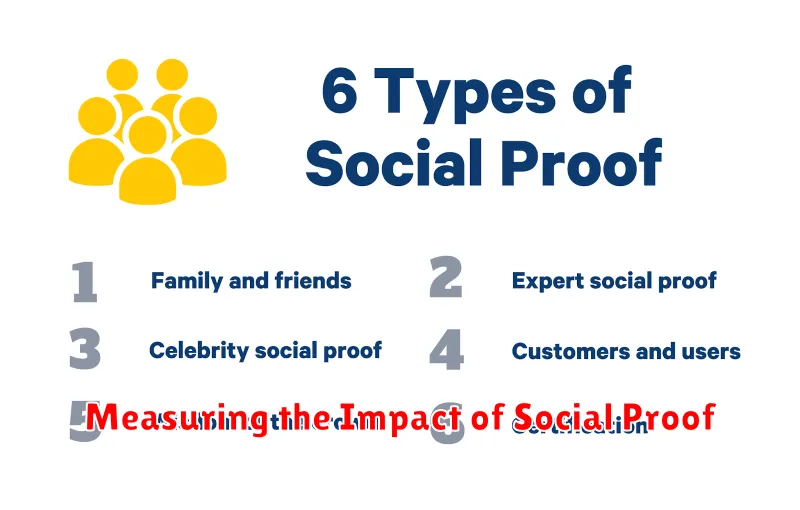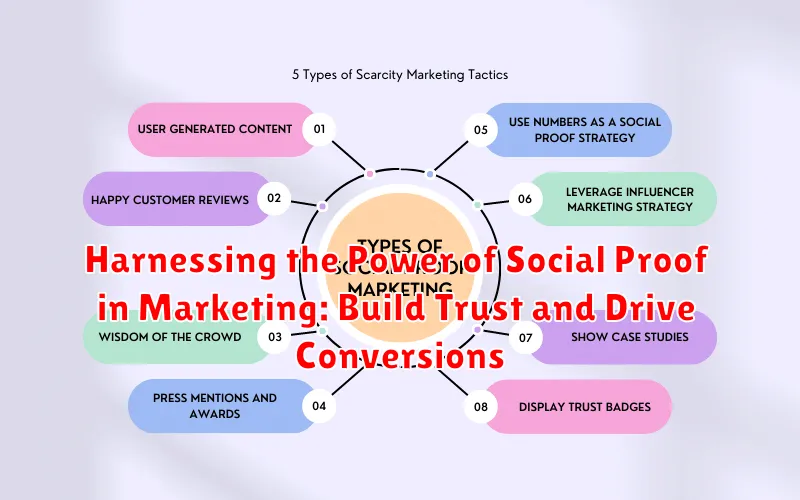In today’s digital landscape, establishing trust and driving conversions are paramount to any successful marketing strategy. Social proof has emerged as a powerful tool for achieving these objectives. Harnessing the power of social proof allows businesses to leverage the influence of others to build credibility, increase brand awareness, and ultimately persuade potential customers to take action. This article will explore the multifaceted nature of social proof marketing and provide practical strategies for implementing it effectively to optimize your marketing efforts and achieve demonstrable results.
From testimonials and online reviews to influencer endorsements and user-generated content, the various forms of social proof offer valuable opportunities to build trust and influence consumer behavior. Understanding how to effectively integrate social proof into your marketing campaigns is crucial for maximizing its impact. By strategically incorporating elements of social proof, businesses can establish a strong sense of legitimacy, reduce purchase anxiety among potential customers, and significantly improve their conversion rates. We will delve into the different types of social proof, discuss their respective strengths, and outline best practices for leveraging them to elevate your marketing strategy and achieve tangible business growth.
What is Social Proof and Why is it Important?
Social proof is a psychological phenomenon where people conform to the actions of others under the assumption that those actions are reflective of correct behavior. In marketing, social proof leverages this principle to influence potential customers. It’s the “everyone else is doing it, so should I” mentality.
Why is it important? Because it builds trust. In today’s information-saturated world, consumers are bombarded with choices. They rely on cues to help them decide what to buy, where to eat, and who to trust. Social proof provides those cues by showcasing the positive experiences of others.
When a potential customer sees that others have used and enjoyed a product or service, they’re more likely to believe in its value and make a purchase. It reduces uncertainty and perceived risk, ultimately driving conversions.
Different Types of Social Proof in Marketing
Social proof takes various forms, each influencing consumer behavior in different ways. Understanding these types is crucial for effective marketing.
1. Expert Social Proof
This involves endorsements from credible industry experts. An expert’s approval adds weight and legitimacy to your product or service.
2. Celebrity Social Proof
Leveraging a celebrity’s popularity can generate significant buzz and brand awareness. Consumers often associate positive celebrity attributes with endorsed products.
3. User Social Proof
This stems from the experiences of everyday consumers, like online reviews, testimonials, and case studies. Potential customers often relate to user experiences, making it a powerful form of social proof.
4. Wisdom of the Crowd Social Proof
Large numbers of people choosing a product or service suggests its value and desirability. This can be highlighted with phrases like “9 out of 10 dentists recommend” or showcasing impressive sales figures.
5. Wisdom of Friends Social Proof
People are heavily influenced by the choices of their friends and family. This type of social proof leverages the trust inherent in personal relationships.
How to Build Social Proof for Your Brand
Building social proof takes time and effort, but the payoff can be significant. Here’s how to cultivate social proof for your brand:
Encourage Reviews and Testimonials
Actively solicit feedback from satisfied customers. Make the process easy by providing direct links to review platforms. Feature positive testimonials prominently on your website and marketing materials.
Showcase User-Generated Content
Encourage customers to share their experiences with your brand on social media. Repost and highlight this content to demonstrate authentic engagement with your product or service. Consider running contests or campaigns to generate user-generated content.
Highlight Media Mentions and Awards
If your brand has been featured in publications or received industry awards, prominently display these accolades. This third-party validation adds significant credibility.
Build a Strong Social Media Presence
Maintain active and engaging social media profiles. Consistent posting and interaction demonstrate a vibrant community and build brand trust. Respond to comments and messages promptly to foster connection with your audience.
Partner with Influencers
Collaborate with relevant influencers in your niche. Their endorsement can introduce your brand to a wider audience and lend credibility to your offerings.
Leveraging Social Proof in Your Marketing Campaigns
Once you’ve built a foundation of social proof, strategically integrate it into your marketing campaigns to maximize impact. Highlight positive customer testimonials in email marketing and on product pages.
Feature user-generated content, showcasing how real people interact with your brand. This could include customer photos, videos, or written reviews. Weave these authentic experiences into your social media strategy and website content.
Showcase influencer collaborations and endorsements. Partnering with relevant influencers can expose your brand to a wider audience and build credibility through association. Ensure influencer selection aligns with your brand values and target demographic.
Promote case studies to illustrate successful outcomes for your clients or customers. Data-driven success stories provide tangible evidence of your value proposition and resonate strongly with potential buyers.
Measuring the Impact of Social Proof

Measuring the impact of social proof is crucial to understanding its effectiveness and optimizing your marketing strategies. Key Performance Indicators (KPIs) can provide valuable insights into how social proof influences consumer behavior.
Website analytics are essential for tracking metrics like conversion rates, bounce rates, and time spent on page. Increases in these metrics, particularly on pages featuring social proof elements, suggest a positive impact.
Social media engagement is another important metric. Track likes, shares, comments, and follower growth. An uptick in these areas can indicate that social proof is resonating with your target audience.
Sales data, particularly when tied to specific social proof campaigns, provides direct evidence of its impact on revenue generation. Monitor sales figures before, during, and after implementing social proof tactics to measure their effectiveness.
Finally, customer surveys and feedback offer qualitative insights into how consumers perceive your brand and the influence of social proof on their purchase decisions.
Best Practices for Using Social Proof Effectively
Leveraging social proof effectively requires careful planning and execution. Authenticity is paramount. Fabricated testimonials erode trust and damage your brand. Focus on showcasing genuine customer experiences.
Target your social proof to specific customer segments. A testimonial from a CEO resonates differently than one from a first-time user. Align the type of social proof with the buyer persona you’re targeting.
Highlight specific benefits and results. Instead of generic praise, showcase quantifiable achievements. Did a customer increase their sales by 15% using your product? Feature that! Use data and numbers to bolster credibility.
Diversify your social proof methods. Don’t rely solely on testimonials. Explore user-generated content, expert endorsements, and social media mentions to create a well-rounded and compelling narrative.
Finally, regularly update your social proof. Fresh testimonials and recent statistics demonstrate ongoing relevance and keep your marketing efforts effective.
Common Mistakes to Avoid with Social Proof Marketing
While social proof can be a powerful tool, its effectiveness hinges on proper implementation. Avoid these common pitfalls to ensure your social proof strategy delivers results.
Using Fake or Inauthentic Testimonials
Authenticity is key. Fabricated testimonials erode trust and can damage your brand’s reputation. Focus on genuine feedback from real customers.
Ignoring Negative Reviews
Addressing negative reviews demonstrates transparency. Ignoring them can appear deceptive. Respond thoughtfully and offer solutions to show you value customer feedback.
Overusing or Misplacing Social Proof
Too much social proof can overwhelm potential customers. Strategic placement is crucial. Highlight relevant testimonials and statistics at key decision points in the customer journey.
Not Diversifying Social Proof Methods
Relying solely on one type of social proof limits your reach. Explore a variety of methods such as customer reviews, expert endorsements, and user-generated content to maximize impact.
Failing to Measure and Analyze Results
Track the performance of your social proof campaigns. Analyze which tactics resonate most with your target audience and refine your strategy accordingly.
Case Studies of Successful Social Proof Campaigns

Examining real-world examples illustrates the impact of effectively implemented social proof strategies.
Case Study 1: A Fitness Apparel Brand
This brand leveraged user-generated content, showcasing customer testimonials and photos featuring their products. This strategy resulted in a 20% increase in website conversions within three months.
Case Study 2: A Software Company
By incorporating customer reviews directly on their product pages, this company saw a 15% uplift in trial sign-ups. The readily available positive feedback instilled confidence in potential customers.
Case Study 3: An E-commerce Platform
This platform implemented real-time purchase notifications, displaying recent purchases to browsing customers. This subtle form of social proof led to a 10% increase in average order value.
The Future of Social Proof in the Digital Age
The digital landscape is constantly evolving, and social proof strategies must adapt. Artificial intelligence (AI) is poised to play a significant role, enabling more personalized and dynamic social proof experiences. Imagine AI curating testimonials based on individual user profiles, delivering highly relevant and impactful endorsements.
Augmented reality (AR) and virtual reality (VR) offer intriguing possibilities. Consumers might virtually “try on” clothes seen on influencers or experience a product demonstration through VR, incorporating social proof directly into the purchase journey.
Blockchain technology could enhance the authenticity and transparency of social proof. Verified reviews and endorsements, secured on the blockchain, could eliminate concerns about fake reviews and build greater trust with consumers.
Finally, the increasing importance of user-generated content (UGC) will continue to shape social proof. Brands will need to become adept at leveraging and showcasing authentic UGC to build credibility and connection with their target audiences.

